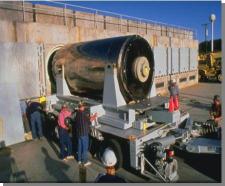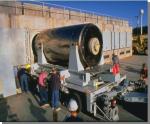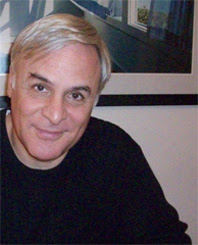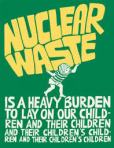A last nights Community Engagement Panel on the decommissioning of the San Onofre Nuclear Waste Generating station a whistleblower named David Fitch stepped forward and said “I probably won’t have a job tomorrow, but I am doing this for my daughter.”…
Continue readingTag Archives: SONGS
A last nights Community Engagement Panel on the decommissioning of the San Onofre Nuclear Waste Generating station a whistleblower named David Fitch stepped forward and said “I probably won’t have a job tomorrow, but I am doing this for my daughter.”…
Continue readingA last nights Community Engagement Panel on the decommissioning of the San Onofre Nuclear Waste Generating station a whistleblower named David Fitch stepped forward and said “I probably won’t have a job tomorrow, but I am doing this for my daughter.”…
Continue readingGene Stone & Darin R. McClure with our bGeigies Come learn about our recent trip to SONGS and our plan for public real time radiation monitoring on location at the San Onofre Nuclear Waste Site at So Cal Edison’s next Community Engagement Pane…
Continue readingGene Stone & Darin R. McClure with our bGeigies Come learn about our recent trip to SONGS and our plan for public real time radiation monitoring on location at the San Onofre Nuclear Waste Site at So Cal Edison’s next Community Engagement Pane…
Continue reading A number of CEP members have expressed a strong interest in returning to the matter of long-term spent fuel storage early in 2015. We are fortunate to have been approached by the Washington DC-based Bipartisan Policy Center (BPC) to organize a joint meeting with the CEP in January as part of an 18-month effort to generate action on the movement of used nuclear fuel in the U.S. With the short timeframe, we will need to finalize the event very quickly.
A number of CEP members have expressed a strong interest in returning to the matter of long-term spent fuel storage early in 2015. We are fortunate to have been approached by the Washington DC-based Bipartisan Policy Center (BPC) to organize a joint meeting with the CEP in January as part of an 18-month effort to generate action on the movement of used nuclear fuel in the U.S. With the short timeframe, we will need to finalize the event very quickly.PLEASE Turn off a light for Fukushima USA / San Onofre
 A number of CEP members have expressed a strong interest in returning to the matter of long-term spent fuel storage early in 2015. We are fortunate to have been approached by the Washington DC-based Bipartisan Policy Center (BPC) to organize a joint meeting with the CEP in January as part of an 18-month effort to generate action on the movement of used nuclear fuel in the U.S. With the short timeframe, we will need to finalize the event very quickly.
A number of CEP members have expressed a strong interest in returning to the matter of long-term spent fuel storage early in 2015. We are fortunate to have been approached by the Washington DC-based Bipartisan Policy Center (BPC) to organize a joint meeting with the CEP in January as part of an 18-month effort to generate action on the movement of used nuclear fuel in the U.S. With the short timeframe, we will need to finalize the event very quickly.PLEASE Turn off a light for Fukushima USA / San Onofre
 A number of CEP members have expressed a strong interest in returning to the matter of long-term spent fuel storage early in 2015. We are fortunate to have been approached by the Washington DC-based Bipartisan Policy Center (BPC) to organize a joint meeting with the CEP in January as part of an 18-month effort to generate action on the movement of used nuclear fuel in the U.S. With the short timeframe, we will need to finalize the event very quickly.
A number of CEP members have expressed a strong interest in returning to the matter of long-term spent fuel storage early in 2015. We are fortunate to have been approached by the Washington DC-based Bipartisan Policy Center (BPC) to organize a joint meeting with the CEP in January as part of an 18-month effort to generate action on the movement of used nuclear fuel in the U.S. With the short timeframe, we will need to finalize the event very quickly.PLEASE Turn off a light for Fukushima USA / San Onofre
 In my opinion, I’m very concerned about the way the SCE/CEP was set up and the direction the leadership of SCE/CEP is now taking us. Instead of taking the neutral position and uncovering and observing the evidence as presented they consistently and obviously put a positive spin on it. Everything is fine and SCE is doing the best job possible.
In my opinion, I’m very concerned about the way the SCE/CEP was set up and the direction the leadership of SCE/CEP is now taking us. Instead of taking the neutral position and uncovering and observing the evidence as presented they consistently and obviously put a positive spin on it. Everything is fine and SCE is doing the best job possible.- We must ask ourselves does this repeated positive spin serve the public interest? In my opinion No.
- Is this Community Engagement Panel doing the best job possible to protect the safety of our communities and California? In my opinion we are not.
- Can or will the SCE/CEP make the changes necessary in its charter to become an effective and strong safety advocate for the decommissioning and safe storage of nuclear waste at San Onofre that the people of California deserve until such time as the DOE takes possession of this long-term problem? In my opinion that is still up in the air.
Related articles
 Fukushima Clean-Up Based On Shady Science And Tax Payer Rip-Off
Fukushima Clean-Up Based On Shady Science And Tax Payer Rip-Off Where will all our nuclear waste go? Disposal is at a critical stage, feds say
Where will all our nuclear waste go? Disposal is at a critical stage, feds say State Approves $3.3 Billion Settlement to Close San Onofre
State Approves $3.3 Billion Settlement to Close San Onofre Plan divides billions in closed nuke plant costs
Plan divides billions in closed nuke plant costs Consumers to pay $3.3 billion in deal to divide costs from closed San Onofre nuclear plant
Consumers to pay $3.3 billion in deal to divide costs from closed San Onofre nuclear plant Ratepayers file suit over San Onofre nuclear plant
Ratepayers file suit over San Onofre nuclear plant
PLEASE Turn off a light for Fukushima USA / San Onofre
 In my opinion, I’m very concerned about the way the SCE/CEP was set up and the direction the leadership of SCE/CEP is now taking us. Instead of taking the neutral position and uncovering and observing the evidence as presented they consistently and obviously put a positive spin on it. Everything is fine and SCE is doing the best job possible.
In my opinion, I’m very concerned about the way the SCE/CEP was set up and the direction the leadership of SCE/CEP is now taking us. Instead of taking the neutral position and uncovering and observing the evidence as presented they consistently and obviously put a positive spin on it. Everything is fine and SCE is doing the best job possible.- We must ask ourselves does this repeated positive spin serve the public interest? In my opinion No.
- Is this Community Engagement Panel doing the best job possible to protect the safety of our communities and California? In my opinion we are not.
- Can or will the SCE/CEP make the changes necessary in its charter to become an effective and strong safety advocate for the decommissioning and safe storage of nuclear waste at San Onofre that the people of California deserve until such time as the DOE takes possession of this long-term problem? In my opinion that is still up in the air.
Related articles
 Fukushima Clean-Up Based On Shady Science And Tax Payer Rip-Off
Fukushima Clean-Up Based On Shady Science And Tax Payer Rip-Off Where will all our nuclear waste go? Disposal is at a critical stage, feds say
Where will all our nuclear waste go? Disposal is at a critical stage, feds say State Approves $3.3 Billion Settlement to Close San Onofre
State Approves $3.3 Billion Settlement to Close San Onofre Plan divides billions in closed nuke plant costs
Plan divides billions in closed nuke plant costs Consumers to pay $3.3 billion in deal to divide costs from closed San Onofre nuclear plant
Consumers to pay $3.3 billion in deal to divide costs from closed San Onofre nuclear plant Ratepayers file suit over San Onofre nuclear plant
Ratepayers file suit over San Onofre nuclear plant
PLEASE Turn off a light for Fukushima USA / San Onofre
In a nutshell all we are saying is that this process should be slowed down to ensure the best possible choice of dry cask canisters is made, spend the money wisely “once” to avert another steam generator type disaster and ensure the safety of California’s future. Gene Stone & Donna Gilmore.

SanOnofreSafety.org
949-204-7794, dgilmore@cox.net
Residents Organized for a Safe Environment (ROSE)
Member, SONGS Community Engagement Panel
949-233-7724, genston@sbcglobal.net
PLEASE Turn off a light for Fukushima USA / San Onofre
Here are two important notes from David G. Victor SCE/CEP chairman. Reading these carefully will give you insight into David’s understanding and misconceptions of how Southern California should proceed with the decommissioning of SONGS and it’s new life as a Nuclear Waste Dump, and how in the world to work with the NRC.
Share this:
PLEASE Turn off a light for Fukushima USA / San Onofre

• Require the NRC to cease its current practice of issuing exemptions to emergency response and security requirements for spent fuel at closed nuclear reactors, unless all fuel storage at the site is in dry casks.
• Ensure that host states and communities have a meaningful role in shaping decommissioning plans for retired nuclear plants.
• Require for the first time that the NRC to explicitly and publicly approve or reject each proposed decommissioning plan.
• Ensure operator compliance with the NRC requirement that spent nuclear fuel be removed from pools and placed into dry cask storage within 7 years after the decommissioning plan is submitted to the NRC.
• Provide funding to help reactor licensees implement plans for decommissioning nuclear plants.
• Expand the emergency planning zone for non-compliant reactor operators to 50 miles.
These sensible steps do not in themselves deal with on-site storage design technology or remote site development. But they are in the spirit of comprehensive nuclear waste management, which remains one of America’s largest environmental challenges.
Sierra Club
PLEASE Turn off a light for Fukushima USA / San Onofre
Issues involving Storage and Transportation of High Burnup Nuclear Fuel
Marvin Resnikoff, Ph.D.
San Juan Capistrano Community Center
• Little technical support for NRC approval of high burnup fuel (HBF). Experiment taking place in the field.
• Total amount of HBF unknown. At a minimum, the NRC should survey utilities.
• HBF will postpone storage up to 20 years; 32 PWR canister extends cooldown period.
• Cladding defects are a major problem for HBF; HBF may not be retrievable. HBF should be canned.
• Because of corrosion, long-term storage may not be possible in a salt environment.
• Side impact rail accidents may shatter HBF cladding.
• Long duration, high temperature fires may involve oil tankers that travel the same tracks. NRC has not properly quantified the statistical likelihood.
PLEASE Turn off a light for Fukushima USA / San Onofre
| Get SCE Out of San Onofre |
Background: NRC Spent Fuel Pool Cooling Requirements:
Related articles
PLEASE Turn off a light for Fukushima USA / San Onofre
PLEASE Turn off a light for Fukushima USA / San Onofre
 |
| Joe Mangano The Radiation and Public Health Project P.O. Box 1260 Ocean City NJ 08226 |
Everyone and especially those with small children should consider making a donation to Joe Mangano’s* The Radiation and Public Health Project for publishing his San Onofre Cancer Report at no cost, as a public service.
CANCER RISKS STUDIED NEAR 7 US NUCLEAR SITES
— Oct. 24 2:03 PM EDT
You are here
Related articles
 NRC Public Meeting On the Process To Decommission San Onofre
NRC Public Meeting On the Process To Decommission San Onofre San Diego Gas & Electric wants to recover San Onofre investment
San Diego Gas & Electric wants to recover San Onofre investment Group links Palisades to death rates; company disputes report
Group links Palisades to death rates; company disputes report Decades later, Baby Tooth Survey legacy lives on
Decades later, Baby Tooth Survey legacy lives on Calls for US seafood testing after revelations of Fukushima radiation leaks
Calls for US seafood testing after revelations of Fukushima radiation leaks How to support the “Nuclear Waste Symposium”
How to support the “Nuclear Waste Symposium”

PLEASE Turn off a light for Fukushima USA / San Onofre
http://residentsorganizedforasafeenvironment.wordpress.com/
Related articles
 Symposium on Decommissioning San Onofre and the Ongoing Dangers of Nuclear Waste
Symposium on Decommissioning San Onofre and the Ongoing Dangers of Nuclear Waste Public meeting about decommissioning process for san Onofre Nuclear Power PLant
Public meeting about decommissioning process for san Onofre Nuclear Power PLant Hot Spot Near West Lake Landfill Raises Concerns
Hot Spot Near West Lake Landfill Raises Concerns Oregon GOP Official: Drop nuclear waste from airplanes for its health benefits – Add radioactive material from San Onofre to our drinking water (VIDEO)
Oregon GOP Official: Drop nuclear waste from airplanes for its health benefits – Add radioactive material from San Onofre to our drinking water (VIDEO) Fukushima’s continuing struggles raise questions about America’s nuclear waste storage
Fukushima’s continuing struggles raise questions about America’s nuclear waste storage

PLEASE Turn off a light for Fukushima USA / San Onofre
Leadership; doing things that ought to be done with hopes that others will see what you have done and will follow some of the examples you have set. & Just Three Of The Reasons Why We Do This. Meet the activists that Decommissioned&n…
Continue reading









